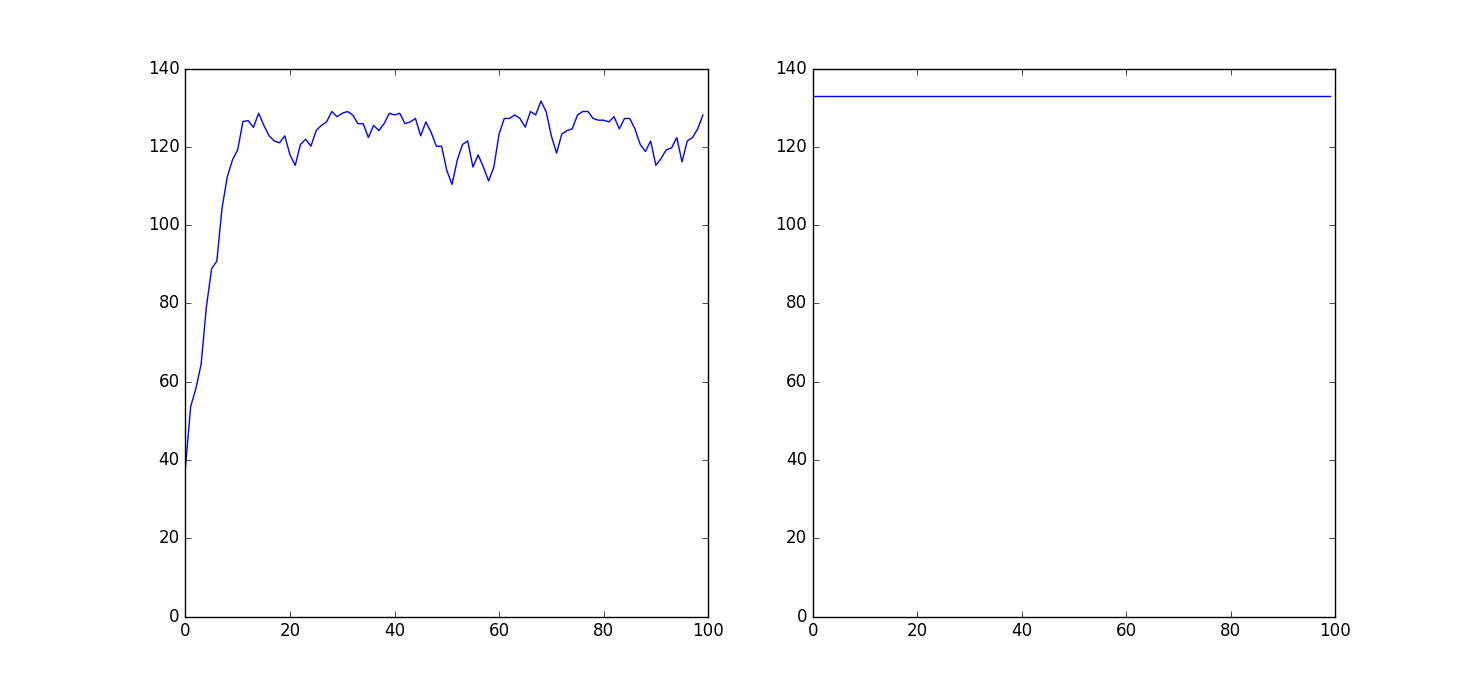1 import numpy
2 import matplotlib.pyplot as plt
3
4
5 data = numpy.array([[77, 92],
6 [22, 22],
7 [29, 87],
8 [50, 46],
9 [99, 90]])
10
11
12 class GA(object):
13 """
14 遗传算法解决0-1背包问题
15 """
16
17 def __init__(self, length, number, iter_number):
18 """
19 参数初始化
20 :param length: 5
21 :param number: 300
22 :param iter_number: 300
23 """
24 self.length = length # 确定染色体编码长度
25 self.number = number # 确定初始化种群数量
26 self.iteration = iter_number # 设置迭代次数
27 self.bag_capacity = 100 # 背包容量
28
29 self.retain_rate = 0.2 # 每一代精英选择出前20%
30 self.random_selection_rate = 0.5 # 对于不是前20%的,有0.5的概率可以进行繁殖
31 self.mutation_rate = 0.01 # 变异概率0.01
32
33 def initial_population(self):
34 """
35 种群初始化,
36
37 :return: 返回种群集合
38 """
39 init_population = numpy.random.randint(low=0, high=2, size=[self.length, self.number], dtype=numpy.int16)
40 return init_population
41
42 def weight_price(self, chromosome):
43 """
44 计算累计重量和累计价格
45 :param chromosome:
46 :return:返回每一个个体的累计重量和价格
47 """
48 w_accumulation = 0
49 p_accumulation = 0
50 for i in range(len(chromosome)):
51
52 w = chromosome[i]*data[i][0]
53 p = chromosome[i]*data[i][1]
54 w_accumulation = w + w_accumulation
55 p_accumulation = p + p_accumulation
56
57 return w_accumulation, p_accumulation
58
59 def fitness_function(self, chromosome):
60 """
61 计算适应度函数,一般来说,背包的价值越高越好,但是
62 当重量超过100时,适应度函数=0
63 :param chromosome:
64 :return:
65 """
66
67 weight, price = self.weight_price(chromosome)
68 if weight > self.bag_capacity:
69 fitness = 0
70 else:
71 fitness = price
72
73 return fitness
74
75 def fitness_average(self, init_population):
76 """
77 求出这个种群的平均适应度,才能知道种群已经进化好了
78 :return:返回的是一个种群的平均适应度
79 """
80 f_accumulation = 0
81 for z in range(init_population.shape[1]):
82 f_tem = self.fitness_function(init_population[:, z])
83 f_accumulation = f_accumulation + f_tem
84 f_accumulation = f_accumulation/init_population.shape[1]
85 return f_accumulation
86
87 def selection(self, init_population):
88 """
89 选择
90 :param init_population:
91 :return: 返回选择后的父代,数量是不定的
92 """
93 sort_population = numpy.array([[], [], [], [], [], []]) # 生成一个排序后的种群列表,暂时为空
94 for i in range(init_population.shape[1]):
95
96 x1 = init_population[:, i]
97 # print('打印x1', x1)
98 x2 = self.fitness_function(x1)
99 x = numpy.r_[x1, x2]
100 # print('打印x', x)
101 sort_population = numpy.c_[sort_population, x]
102
103 sort_population = sort_population.T[numpy.lexsort(sort_population)].T # 联合排序,从小到大排列
104
105 # print('排序后长度', sort_population.shape[1])
106 print(sort_population)
107
108 # 选出适应性强的个体,精英选择
109 retain_length = sort_population.shape[1]*self.retain_rate
110
111 parents = numpy.array([[], [], [], [], [], []]) # 生成一个父代列表,暂时为空
112 for j in range(int(retain_length)):
113 y1 = sort_population[:, -(j+1)]
114 parents = numpy.c_[parents, y1]
115
116 # print(parents.shape[1])
117
118 rest = sort_population.shape[1] - retain_length # 精英选择后剩下的个体数
119 for q in range(int(rest)):
120
121 if numpy.random.random() < self.random_selection_rate:
122 y2 = sort_population[:, q]
123 parents = numpy.c_[parents, y2]
124
125 parents = numpy.delete(parents, -1, axis=0) # 删除最后一行,删除了f值
126 # print('打印选择后的个体数')
127 # print(parents.shape[0])
128
129 parents = numpy.array(parents, dtype=numpy.int16)
130
131 return parents
132
133 def crossover(self, parents):
134 """
135 交叉生成子代,和初始化的种群数量一致
136 :param parents:
137 :return:返回子代
138 """
139 children = numpy.array([[], [], [], [], []]) # 子列表初始化
140
141 while children.shape[1] < self.number:
142 father = numpy.random.randint(0, parents.shape[1] - 1)
143 mother = numpy.random.randint(0, parents.shape[1] - 1)
144 if father != mother:
145 # 随机选取交叉点
146 cross_point = numpy.random.randint(0, self.length)
147 # 生成掩码,方便位操作
148 mark = 0
149 for i in range(cross_point):
150 mark |= (1 << i)
151
152 father = parents[:, father]
153 # print(father)
154 mother = parents[:, mother]
155
156 # 子代将获得父亲在交叉点前的基因和母亲在交叉点后(包括交叉点)的基因
157 child = ((father & mark) | (mother & ~mark)) & ((1 << self.length) - 1)
158
159 children = numpy.c_[children, child]
160
161 # 经过繁殖后,子代的数量与原始种群数量相等,在这里可以更新种群。
162 # print('子代数量', children.shape[1])
163 # print(children.dtype)
164 children = numpy.array(children, dtype=numpy.int16)
165 return children
166
167 def mutation(self, children):
168 """
169 变异
170
171 :return:
172 """
173 for i in range(children.shape[1]):
174
175 if numpy.random.random() < self.mutation_rate:
176 j = numpy.random.randint(0, self.length - 1) # s随机产生变异位置
177 children[:, i] ^= 1 << j # 产生变异
178 children = numpy.array(children, dtype=numpy.int16)
179 return children
180
181 def plot_figure(self, iter_plot, f_plot, f_set_plot):
182 """
183 画出迭代次数和平均适应度曲线图
184 画出迭代次数和每一步迭代最大值图
185 :return:
186 """
187 plt.figure()
188
189 ax1 = plt.subplot(121)
190 ax2 = plt.subplot(122)
191
192 plt.sca(ax1)
193 plt.plot(iter_plot, f_plot)
194 plt.ylim(0, 140) # 设置y轴范围
195
196 plt.sca(ax2)
197 plt.plot(iter_plot, f_set_plot)
198 plt.ylim(0, 140) # 设置y轴范围
199 plt.show()
200
201 def main(self):
202 """
203 main函数,用来进化
204 对当前种群依次进行选择、交叉并生成新一代种群,然后对新一代种群进行变异
205 :return:
206 """
207 init_population = self.initial_population()
208 # print(init_population)
209
210 iter_plot = []
211 f_plot = []
212 iteration = 0
213
214 f_set_plot = []
215
216 while iteration < self.iteration: # 设置迭代次数300
217
218 parents = self.selection(init_population) # 选择后的父代
219 children = self.crossover(parents)
220 mutation_children = self.mutation(children)
221
222 init_population = mutation_children
223
224 f_set = [] # 求出每一步迭代的最大值
225 for init in range(init_population.shape[1]):
226 f_set_tem = self.fitness_function(init_population[:, init])
227 f_set.append(f_set_tem)
228
229 f_set = max(f_set)
230
231 f_set_plot.append(f_set)
232
233 iter_plot.append(iteration)
234 iteration = iteration+1
235 print("第%s进化得如何******************************************" % iteration)
236 f_average = self.fitness_average(init_population)
237 f_plot.append(f_average)
238 print(f_set)
239 # f_accumulation = f_accumulation + f
240 # f_print = f_accumulation/(iteration + 1)
241 # print(f_print)
242 self.plot_figure(iter_plot, f_plot, f_set_plot)
243
244
245 if __name__ == '__main__':
246 g1 = GA(5, 300, 100)
247 g1.main()






